Zihao Chen
for the ALFA study
SLIM: Subtrajectory-Level Elimination for More Effective Reasoning
Aug 27, 2025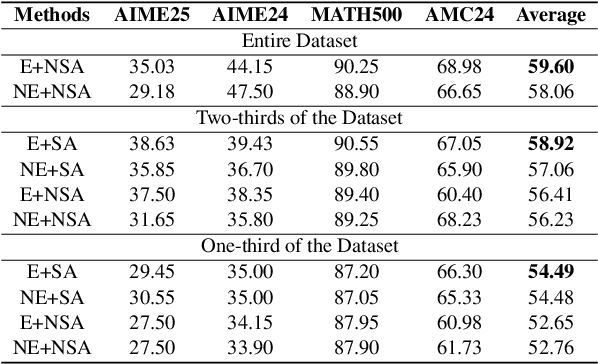
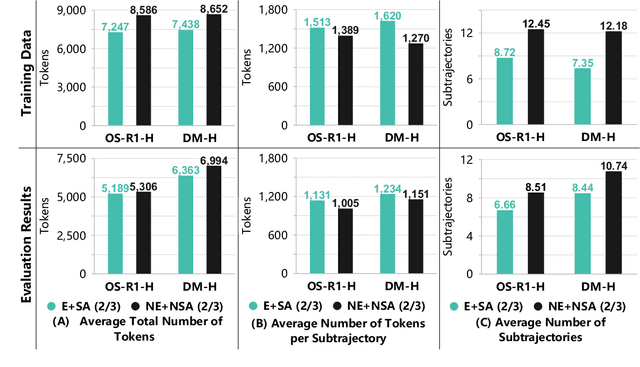
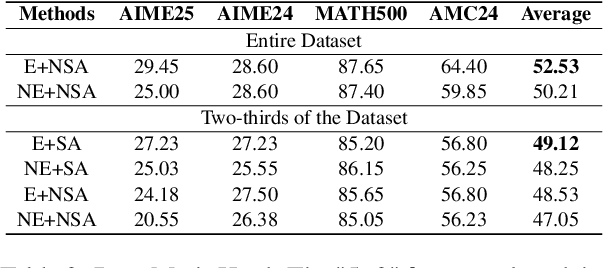
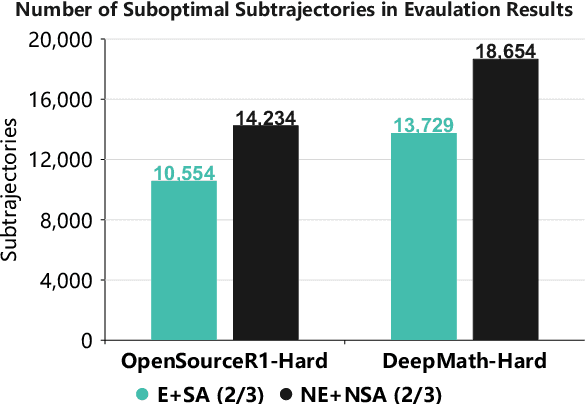
Abstract:In recent months, substantial progress has been made in complex reasoning of Large Language Models, particularly through the application of test-time scaling. Notable examples include o1/o3/o4 series and DeepSeek-R1. When responding to a query, these models generate an extended reasoning trajectory, during which the model explores, reflects, backtracks, and self-verifies before arriving at a conclusion. However, fine-tuning models with such reasoning trajectories may not always be optimal. Our findings indicate that not all components within these reasoning trajectories contribute positively to the reasoning process; in fact, some components may affect the overall performance negatively. In this study, we divide a reasoning trajectory into individual subtrajectories and develop a "5+2" framework to: (1) systematically identify suboptimal subtrajectories within the reasoning trajectory based on five human-established criteria; (2) assess the independence of the suboptimal subtrajectories identified in (1) from the subsequent content, ensuring that their elimination does not compromise overall flow and coherence of the reasoning process. Additionally, a sampling algorithm, built upon the "5+2" framework, is employed to select data whose reasoning process is free from suboptimal subtrajectories to the highest degree. Experimental results demonstrate that our method can reduce the number of suboptimal subtrajectories by 25.9\% during the inference. Furthermore, our method achieves an average accuracy of 58.92\% on highly challenging math benchmarks with only two thirds of training data, surpassing the average accuracy of 58.06\% achieved with the entire data, and outperforming open-source datasets, when fine-tuning Qwen2.5-Math-7B. Finally, We validated our method under resource constraints and observed improved performance across various inference token limits.
AnalogSeeker: An Open-source Foundation Language Model for Analog Circuit Design
Aug 14, 2025Abstract:In this paper, we propose AnalogSeeker, an effort toward an open-source foundation language model for analog circuit design, with the aim of integrating domain knowledge and giving design assistance. To overcome the scarcity of data in this field, we employ a corpus collection strategy based on the domain knowledge framework of analog circuits. High-quality, accessible textbooks across relevant subfields are systematically curated and cleaned into a textual domain corpus. To address the complexity of knowledge of analog circuits, we introduce a granular domain knowledge distillation method. Raw, unlabeled domain corpus is decomposed into typical, granular learning nodes, where a multi-agent framework distills implicit knowledge embedded in unstructured text into question-answer data pairs with detailed reasoning processes, yielding a fine-grained, learnable dataset for fine-tuning. To address the unexplored challenges in training analog circuit foundation models, we explore and share our training methods through both theoretical analysis and experimental validation. We finally establish a fine-tuning-centric training paradigm, customizing and implementing a neighborhood self-constrained supervised fine-tuning algorithm. This approach enhances training outcomes by constraining the perturbation magnitude between the model's output distributions before and after training. In practice, we train the Qwen2.5-32B-Instruct model to obtain AnalogSeeker, which achieves 85.04% accuracy on AMSBench-TQA, the analog circuit knowledge evaluation benchmark, with a 15.67% point improvement over the original model and is competitive with mainstream commercial models. Furthermore, AnalogSeeker also shows effectiveness in the downstream operational amplifier design task. AnalogSeeker is open-sourced at https://huggingface.co/analogllm/analogseeker for research use.
Disentangling Granularity: An Implicit Inductive Bias in Factorized VAEs
May 30, 2025Abstract:Despite the success in learning semantically meaningful, unsupervised disentangled representations, variational autoencoders (VAEs) and their variants face a fundamental theoretical challenge: substantial evidence indicates that unsupervised disentanglement is unattainable without implicit inductive bias, yet such bias remains elusive. In this work, we focus on exploring the implicit inductive bias that drive disentanglement in VAEs with factorization priors. By analyzing the total correlation in \b{eta}-TCVAE, we uncover a crucial implicit inductive bias called disentangling granularity, which leads to the discovery of an interesting "V"-shaped optimal Evidence Lower Bound (ELBO) trajectory within the parameter space. This finding is validated through over 100K experiments using factorized VAEs and our newly proposed model, \b{eta}-STCVAE. Notably, experimental results reveal that conventional factorized VAEs, constrained by fixed disentangling granularity, inherently tend to disentangle low-complexity feature. Whereas, appropriately tuning disentangling granularity, as enabled by \b{eta}-STCVAE, broadens the range of disentangled representations, allowing for the disentanglement of high-complexity features. Our findings unveil that disentangling granularity as an implicit inductive bias in factorized VAEs influence both disentanglement performance and the inference of the ELBO, offering fresh insights into the interpretability and inherent biases of VAEs.
Towards Video to Piano Music Generation with Chain-of-Perform Support Benchmarks
May 26, 2025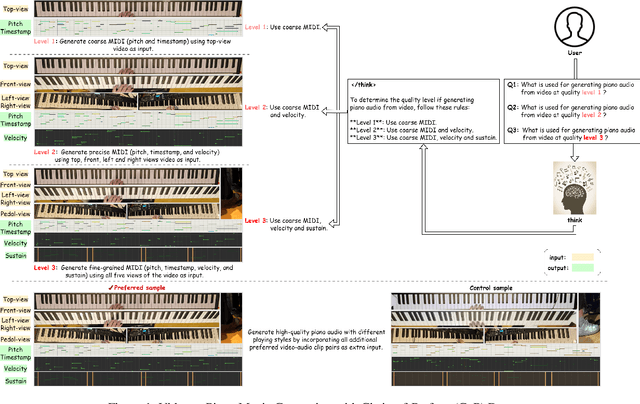
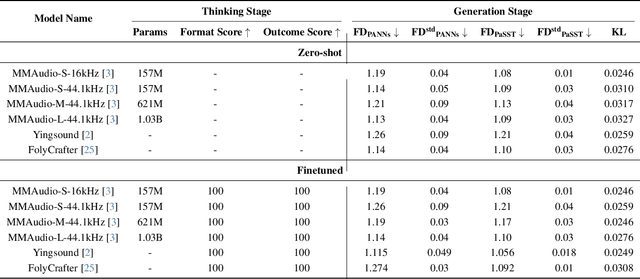
Abstract:Generating high-quality piano audio from video requires precise synchronization between visual cues and musical output, ensuring accurate semantic and temporal alignment.However, existing evaluation datasets do not fully capture the intricate synchronization required for piano music generation. A comprehensive benchmark is essential for two primary reasons: (1) existing metrics fail to reflect the complexity of video-to-piano music interactions, and (2) a dedicated benchmark dataset can provide valuable insights to accelerate progress in high-quality piano music generation. To address these challenges, we introduce the CoP Benchmark Dataset-a fully open-sourced, multimodal benchmark designed specifically for video-guided piano music generation. The proposed Chain-of-Perform (CoP) benchmark offers several compelling features: (1) detailed multimodal annotations, enabling precise semantic and temporal alignment between video content and piano audio via step-by-step Chain-of-Perform guidance; (2) a versatile evaluation framework for rigorous assessment of both general-purpose and specialized video-to-piano generation tasks; and (3) full open-sourcing of the dataset, annotations, and evaluation protocols. The dataset is publicly available at https://github.com/acappemin/Video-to-Audio-and-Piano, with a continuously updated leaderboard to promote ongoing research in this domain.
MM-MovieDubber: Towards Multi-Modal Learning for Multi-Modal Movie Dubbing
May 22, 2025Abstract:Current movie dubbing technology can produce the desired speech using a reference voice and input video, maintaining perfect synchronization with the visuals while effectively conveying the intended emotions. However, crucial aspects of movie dubbing, including adaptation to various dubbing styles, effective handling of dialogue, narration, and monologues, as well as consideration of subtle details such as speaker age and gender, remain insufficiently explored. To tackle these challenges, we introduce a multi-modal generative framework. First, it utilizes a multi-modal large vision-language model (VLM) to analyze visual inputs, enabling the recognition of dubbing types and fine-grained attributes. Second, it produces high-quality dubbing using large speech generation models, guided by multi-modal inputs. Additionally, a movie dubbing dataset with annotations for dubbing types and subtle details is constructed to enhance movie understanding and improve dubbing quality for the proposed multi-modal framework. Experimental results across multiple benchmark datasets show superior performance compared to state-of-the-art (SOTA) methods. In details, the LSE-D, SPK-SIM, EMO-SIM, and MCD exhibit improvements of up to 1.09%, 8.80%, 19.08%, and 18.74%, respectively.
IIKL: Isometric Immersion Kernel Learning with Riemannian Manifold for Geometric Preservation
May 07, 2025Abstract:Geometric representation learning in preserving the intrinsic geometric and topological properties for discrete non-Euclidean data is crucial in scientific applications. Previous research generally mapped non-Euclidean discrete data into Euclidean space during representation learning, which may lead to the loss of some critical geometric information. In this paper, we propose a novel Isometric Immersion Kernel Learning (IIKL) method to build Riemannian manifold and isometrically induce Riemannian metric from discrete non-Euclidean data. We prove that Isometric immersion is equivalent to the kernel function in the tangent bundle on the manifold, which explicitly guarantees the invariance of the inner product between vectors in the arbitrary tangent space throughout the learning process, thus maintaining the geometric structure of the original data. Moreover, a novel parameterized learning model based on IIKL is introduced, and an alternating training method for this model is derived using Maximum Likelihood Estimation (MLE), ensuring efficient convergence. Experimental results proved that using the learned Riemannian manifold and its metric, our model preserved the intrinsic geometric representation of data in both 3D and high-dimensional datasets successfully, and significantly improved the accuracy of downstream tasks, such as data reconstruction and classification. It is showed that our method could reduce the inner product invariant loss by more than 90% compared to state-of-the-art (SOTA) methods, also achieved an average 40% improvement in downstream reconstruction accuracy and a 90% reduction in error for geometric metrics involving isometric and conformal.
Towards Film-Making Production Dialogue, Narration, Monologue Adaptive Moving Dubbing Benchmarks
Apr 30, 2025Abstract:Movie dubbing has advanced significantly, yet assessing the real-world effectiveness of these models remains challenging. A comprehensive evaluation benchmark is crucial for two key reasons: 1) Existing metrics fail to fully capture the complexities of dialogue, narration, monologue, and actor adaptability in movie dubbing. 2) A practical evaluation system should offer valuable insights to improve movie dubbing quality and advancement in film production. To this end, we introduce Talking Adaptive Dubbing Benchmarks (TA-Dubbing), designed to improve film production by adapting to dialogue, narration, monologue, and actors in movie dubbing. TA-Dubbing offers several key advantages: 1) Comprehensive Dimensions: TA-Dubbing covers a variety of dimensions of movie dubbing, incorporating metric evaluations for both movie understanding and speech generation. 2) Versatile Benchmarking: TA-Dubbing is designed to evaluate state-of-the-art movie dubbing models and advanced multi-modal large language models. 3) Full Open-Sourcing: We fully open-source TA-Dubbing at https://github.com/woka- 0a/DeepDubber- V1 including all video suits, evaluation methods, annotations. We also continuously integrate new movie dubbing models into the TA-Dubbing leaderboard at https://github.com/woka- 0a/DeepDubber-V1 to drive forward the field of movie dubbing.
DeepDubber-V1: Towards High Quality and Dialogue, Narration, Monologue Adaptive Movie Dubbing Via Multi-Modal Chain-of-Thoughts Reasoning Guidance
Mar 31, 2025Abstract:Current movie dubbing technology can generate the desired voice from a given speech prompt, ensuring good synchronization between speech and visuals while accurately conveying the intended emotions. However, in movie dubbing, key aspects such as adapting to different dubbing styles, handling dialogue, narration, and monologue effectively, and understanding subtle details like the age and gender of speakers, have not been well studied. To address this challenge, we propose a framework of multi-modal large language model. First, it utilizes multimodal Chain-of-Thought (CoT) reasoning methods on visual inputs to understand dubbing styles and fine-grained attributes. Second, it generates high-quality dubbing through large speech generation models, guided by multimodal conditions. Additionally, we have developed a movie dubbing dataset with CoT annotations. The evaluation results demonstrate a performance improvement over state-of-the-art methods across multiple datasets. In particular, for the evaluation metrics, the SPK-SIM and EMO-SIM increases from 82.48% to 89.74%, 66.24% to 78.88% for dubbing setting 2.0 on V2C Animation dataset, LSE-D and MCD-SL decreases from 14.79 to 14.63, 5.24 to 4.74 for dubbing setting 2.0 on Grid dataset, SPK-SIM increases from 64.03 to 83.42 and WER decreases from 52.69% to 23.20% for initial reasoning setting on proposed CoT-Movie-Dubbing dataset in the comparison with the state-of-the art models.
Enhance Generation Quality of Flow Matching V2A Model via Multi-Step CoT-Like Guidance and Combined Preference Optimization
Mar 28, 2025Abstract:Creating high-quality sound effects from videos and text prompts requires precise alignment between visual and audio domains, both semantically and temporally, along with step-by-step guidance for professional audio generation. However, current state-of-the-art video-guided audio generation models often fall short of producing high-quality audio for both general and specialized use cases. To address this challenge, we introduce a multi-stage, multi-modal, end-to-end generative framework with Chain-of-Thought-like (CoT-like) guidance learning, termed Chain-of-Perform (CoP). First, we employ a transformer-based network architecture designed to achieve CoP guidance, enabling the generation of both general and professional audio. Second, we implement a multi-stage training framework that follows step-by-step guidance to ensure the generation of high-quality sound effects. Third, we develop a CoP multi-modal dataset, guided by video, to support step-by-step sound effects generation. Evaluation results highlight the advantages of the proposed multi-stage CoP generative framework compared to the state-of-the-art models on a variety of datasets, with FAD 0.79 to 0.74 (+6.33%), CLIP 16.12 to 17.70 (+9.80%) on VGGSound, SI-SDR 1.98dB to 3.35dB (+69.19%), MOS 2.94 to 3.49(+18.71%) on PianoYT-2h, and SI-SDR 2.22dB to 3.21dB (+44.59%), MOS 3.07 to 3.42 (+11.40%) on Piano-10h.
DeepAudio-V1:Towards Multi-Modal Multi-Stage End-to-End Video to Speech and Audio Generation
Mar 28, 2025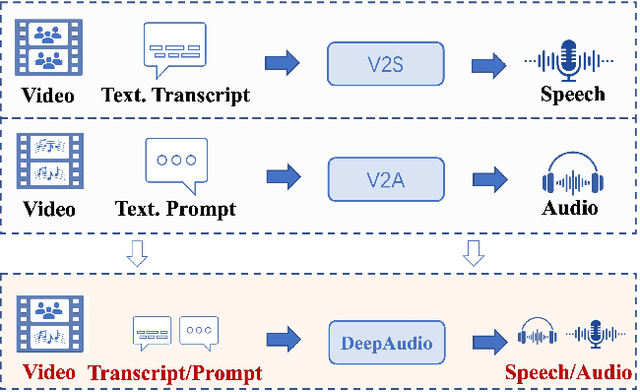
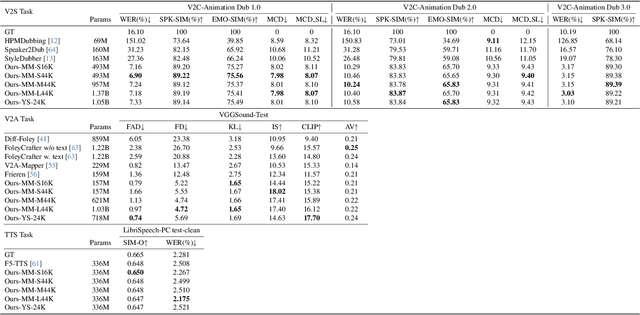
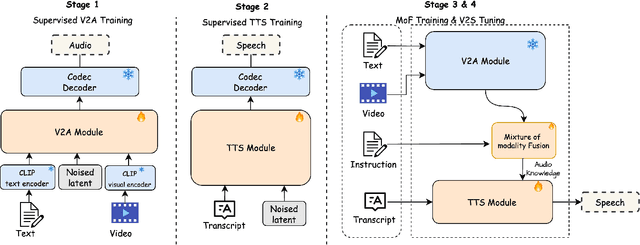

Abstract:Currently, high-quality, synchronized audio is synthesized using various multi-modal joint learning frameworks, leveraging video and optional text inputs. In the video-to-audio benchmarks, video-to-audio quality, semantic alignment, and audio-visual synchronization are effectively achieved. However, in real-world scenarios, speech and audio often coexist in videos simultaneously, and the end-to-end generation of synchronous speech and audio given video and text conditions are not well studied. Therefore, we propose an end-to-end multi-modal generation framework that simultaneously produces speech and audio based on video and text conditions. Furthermore, the advantages of video-to-audio (V2A) models for generating speech from videos remain unclear. The proposed framework, DeepAudio, consists of a video-to-audio (V2A) module, a text-to-speech (TTS) module, and a dynamic mixture of modality fusion (MoF) module. In the evaluation, the proposed end-to-end framework achieves state-of-the-art performance on the video-audio benchmark, video-speech benchmark, and text-speech benchmark. In detail, our framework achieves comparable results in the comparison with state-of-the-art models for the video-audio and text-speech benchmarks, and surpassing state-of-the-art models in the video-speech benchmark, with WER 16.57% to 3.15% (+80.99%), SPK-SIM 78.30% to 89.38% (+14.15%), EMO-SIM 66.24% to 75.56% (+14.07%), MCD 8.59 to 7.98 (+7.10%), MCD SL 11.05 to 9.40 (+14.93%) across a variety of dubbing settings.
 Add to Chrome
Add to Chrome Add to Firefox
Add to Firefox Add to Edge
Add to Edge